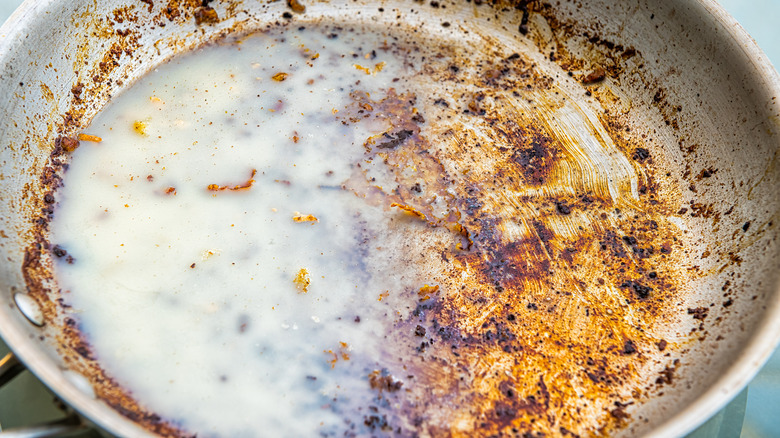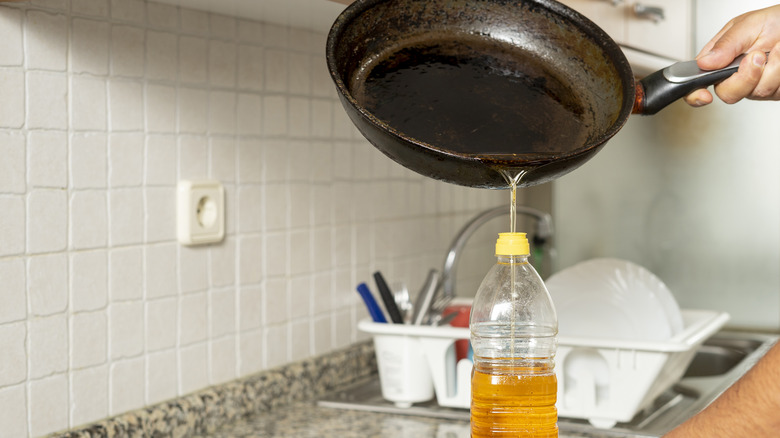The Unconventional Spot Martha Stewart Once Dumped Cooking Grease
Most chefs know that proper grease disposal is important when cooking. And if you're a home cook, you've likely poured off extra fat a time or two. After all, no one likes an overly oily, fatty dish. But where did you put the extra drippings? Perhaps you poured the cooking grease down the drain. While that may seem like the logical thing to do, oil and water don't mix, so the grease will not simply be dissolved or washed away. In fact, pouring grease down the kitchen sink can lead to build-up, causing a nasty, slow drain — or worse — blocked plumbing that can lead to overflows.
Fats, oils, and grease (known municipally as F.O.G.) even gum up sewer pipes and can create revolting "fatbergs" when they combine with non-flushable waste materials, per New York City Environmental Protection. So how does this happen? People don't always follow rules, and often don't know what to do with all the grease that builds up in their kitchen. One such person was a young, newly-married Martha Stewart. Known to be a little rebellious, the icon once did something very strange with her leftover cooking fat.
Gone off the rails
In a cooking video from "Martha" with Jimmy Fallon, the two celebrities make chili together. But once the beef's been browned, discussion begins about what to do with the fat that's left behind. Fallon suggests burying it in the garden and says his mother used to pour it off into a can. But Martha Stewart has other ideas. She says, "You take the bowl down to the train tracks. And you pour it — this is what I used to do — you just pour it down the train tracks." It's hard to imagine the iconic Stewart not knowing how to do anything home, especially kitchen-related, but she adds, "As a newlywed, I didn't know what to do with the grease!"
Fallon teases her by comparing her behavior to that of kids spraying graffiti, but to Stewart, this was a fast way to get rid of F.O.G. We can all laugh with her and Fallon today, but we don't recommend dumping grease on the train tracks or anywhere outside — it's dangerous and could even be illegal. As Insider reports, pouring it out in the yard or compost pile can attract creatures from flies and cockroaches to rats, raccoons, and even bears, depending on your location — and then you'll have a pest control situation on your hands. Fortunately, there are plenty of other ways to ditch kitchen grease.
You can properly toss or reuse cooking oil
Martha Stewart's come a long way since her greasy train track days. If you got some on your clothing, she's got a tried-and-true formula for addressing the stain, plus a less involved oil stain removal method. But how should the home cook contend with waste oil? Interestingly, those big waste oil bins behind restaurants are collected and their contents can be turned into biofuel and animal feed (per Mahoney Environmental). But individuals don't qualify for this service — they must throw away or recycle the grease on their own. Instead of putting grease in the sink or toilet, New York City Environmental Protection explains that you can simply pour it into an empty container, label it "Cooking Oil — Not for Recycling", and throw it away with your household garbage.
You can also freeze the container and toss it later. Use caution when pouring grease and wait until it's cool enough to handle. Also, never add water to the hot oil! Science ABC explains that since water and oil are immiscible, the denser water sinks below the oil vaporizes in the high temperature, and can cause an explosion. If your grease is clean and strained of impurities, you can save it for further cooking. Bacon fat, for instance, has a high smoke point and can be saved for cooking vegetables, sauces, and baked goods. Cooking grease comes with the territory, but consider handling it another crucial culinary skill to master.


